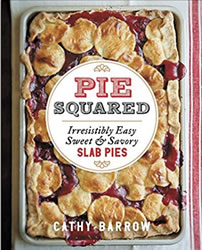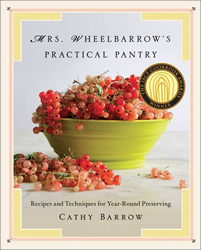Last week, my friend, Eris, came by to make a batch of salsa – the last batch of the season. Eris and her husband, John, and brother in law, Jeff, run Norman’s Farm Market, fantastic farmstands around the Washington, DC area. Their Market has been my source for a good bit of the locally grown produce that has been transformed into jarred goodies (not to mention the weekly CSA box that makes up a good portion of our nightly meals.)
All the produce at the Markets is sourced by John & Jeff, and their truck makes the rounds of the area around DC, the Eastern Shore of Maryland, the Northern Neck of Virginia, and central and southeastern Pennsylvania. The farms all use good sustainable practices, but don’t promise organic. (I’ll be learning more about the challenges of organic certification at Bending Bridge Farm next week.) Nevertheless, the breadth of offerings has been terrific. There were lovely heirloom tomatoes, fantastic varieties of peppers, amazing eggplant types, and, now, spectacular fall squashes of all shapes, colors and sizes.
I’m excited the Market may carry grass-fed meats this winter. Mostly, I wish all the Normans much success. It’s so important to me to support local farmers, eat seasonally, and encourage sustainable practices. If you’re in the area, please visit the Markets. And if you live here, consider the CSA – perhaps the best way to provide support to your local farmer.
Back to the salsa.
So, Eris is getting into canning this year. I know she made some jam, and some pickles. We’ve talked about sauerkraut, as John is a huge fan of kraut. But it’s the salsa that really got her going. My salsa is good – seriously good – and she was determined to learn how to make it. We’ve had one other salsa-session this summer, but with October looming and the certain end of fresh tomatoes, it was time to put some more jars on the shelf.
Salsa requres a pressure canner (as do most tomato products, according to the USDA guidelines) and since I bought one last year, I’ve been enjoying the expanded list of items I can put up. (Not only tomatoes, but tuna and vegetables that aren’t pickled! I’m hoping to try pork rillettes soon.) It’s a big canner – holds 9 pints or 7 quarts – and that’s a lot of produce to chop. It’s great to share the work of chopping and offer half the production as an incentive! Seems fair, and somehow very traditional, sitting around the kitchen table chopping and measuring.
As Eris and I had done this before, everything went really smoothly this time. There’s nothing like company to speed up the chopping, peeling, and deseeding of 12 cups of tomatoes. And lots of peppers, onions and garlic. After that, it’s all babysitting. Stirring the big pot and waiting for the boil. And watching the pressure canner dial. So, there’s plenty of time to hang in the kitchen and talk about life. That’s when I start to feel like one of many women across the centuries who have gathered to preserve foods. I know. Really eye-rolling stuff there. But it does feel that way.
With the salsa planned, knowing the big pots would be up out of the basement, and it would be already hot and steamy and sticky in the kitchen, I decided to make a push and do one final CanORama for 2009.
There were five huge peaches I’d picked up the day before with my CSA box. And some organic strawberries from June that were taking up space in the freezer. And lemon verbena in the garden. Another batch of the peach/strawberry/verbena jam was in order; it’s just heavenly in yogurt. So, I peeled, chopped and tossed everything with sugar and herbs and lemon juice, brought it all to a boil and then set it aside to marinate for a few hours.
The day before, while at the farm stand, the unmistakable scent of concord grapes was in the air. It was so intoxicating, I ordered a trug-full – 13 pounds – and started researching the best way to make juice. Grape juice is extremely healthy – full of antioxidants. It takes just a wash of the grapes, de-stemming and picking over, then a quick boil, a good smashing, another boil and straining, then a 5 minute boiling water bath and you have pints of grape juice on the shelf.
It was a little messy, and next time, I’ll add more water and put it through a finer seive, as the end product is a bit thick. For this year, we’ll thin the juice, once opened, with seltzer or water. It’s very tasty and I look forward to doing more juice making next year. Now that I have the method, I see all sorts of options – blueberry juice? raspberry juice? How fantastic.
All this fancy canning is fun for me, but here’s an easy recipe. You can make this jam using a boiling water bath. It’s so delicious I’m sure you won’t want to share it with anyone. But if you do, I’ll bet you’ll have a canning friend next year, too.
Peach Strawberry Lemon Verbena Jam
adapted from Christine Ferrer
Yields about six 1/2 pints
2.5# (1.14 kg) peaches, peeled, pitted and sliced (frozen can be used)
2# (.9 kg) strawberries, left whole (frozen can be used)
3.5 (875 gr) cups sugar
Juice of one lemon
10 stalks lemon verbena
Bring everything to a boil. Pour into a glass or ceramic bowl, cover with parchment paper and refrigerate at least six hours or overnight.
Bring jam back up to a boil and then simmer gently for 45 minutes. Return to a hard boil that cannot be stirred down. Allow to boil for 5 minutes.
Remove lemon verbena stems.
Pack into hot 1/2 pint jars, the more decorative the better. Wipe the rims and place rings and lids. Process in a boiling water bath for 10 minutes.
Lift the jars out of the bath and place on the counter. Leave them there, undisturbed for several hours. Listen to the satisfying ping of jars sealing.











Leave a Reply